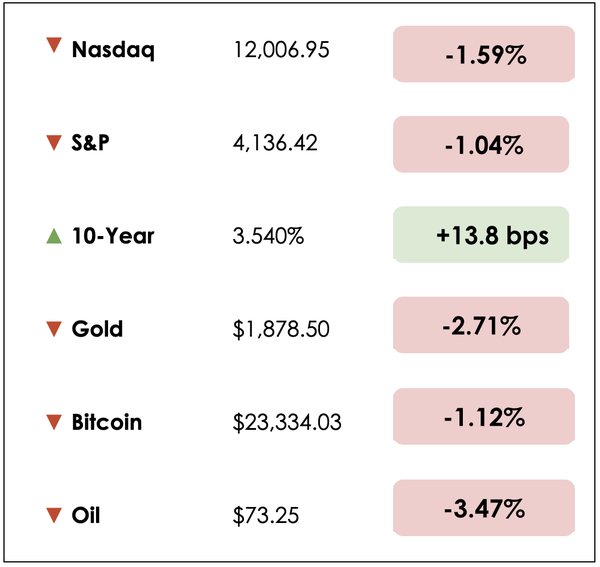Upside-Down Economics
03 February 2023

Hi, The Investor’s Podcast Network Community!
For even the most optimistic market commentators, today’s jobs report was a shock. Axios called it a “blowout” reflecting a “rip-roaring labor market” 🔥
The latest data is a slap in the face to recession narratives: unemployment remains extremely low and falling. Whereas economists anticipated labor market growth to decelerate in January, it surged ahead, adding over half a million new jobs last month.
To have inflation rates slow dramatically, as we’ve seen, while employment picks up despite nearly unprecedented rate hikes has been unexpected, to say the least.
The post-pandemic economy is increasingly turning economic thinking upside down 🙃
More details below.
Here’s the rundown:
MARKETS
*All prices as of market close at 4pm EST
Today, we’ll discuss two items in the news: an almost unbelievable jobs report, and Americans start to drain their retirement funds, plus our main story on why egg prices are so eggspensive (sorry 😬).
All this, and more, in just 5 minutes to read.
Get smarter about valuing businesses in just a few minutes each week.
Get the weekly email that makes understanding intrinsic value
easy and enjoyable, for free.
BROUGHT TO YOU BY: SURE DIVIDEND
The Dividend Kings are the best-of-the-best in dividend longevity. A stock must pay rising dividends every year for 50+ consecutive years to become a Dividend King.
There are currently only 49 Dividend Kings…And the team at Sure Dividend analyzes them all in detail.
Click here to see their in-depth research on Dividend Kings, including the five best Dividend Kings now and a free spreadsheet to download all 49.
IN THE NEWS
💼 Unemployment hits 53-year low (CNBC)
- What recession? The recent jobs report shows nonfarm payrolls increased by 517,000, far higher than the 187,000 market estimate. The unemployment rate fell to 3.4% vs. the 3.6% estimate. That’s the lowest jobless level since May 1969.
- Leisure and hospitality added 128,000 jobs to lead all sectors. Professional and business services (82,000), government (74,000), and health care (58,000) also posted gains.
- Average hourly earnings rose 0.3%, in line with estimates, and up 4.4% from a year ago, though below the December gain of 4.6%. The unemployment rate for Black Americans fell to 5.4%, while the rate for women was 3.1%.
- The surge in job creation comes despite the Federal Reserve’s efforts to slow the economy and bring down inflation from its highest level since the early 1980s. The Fed has raised its benchmark interest rate eight times since March 2022.
- “Today’s jobs report is almost too good to be true,” wrote Julia Pollak, chief economist at ZipRecruiter. “Like $20 bills on the sidewalk and free lunches, falling inflation paired with falling unemployment is the stuff of economics fiction.”
- Added Michelle Meyer, chief U.S. economist at the Mastercard Economics Institute: “It was a phenomenal report. This brings into question how we’re able to see that level of job growth despite some of the other rumblings in the economy. The reality is it shows there’s still a lot of pent-up demand for workers were companies have really struggled to staff appropriately.”
💸 Americans Tap 401(k) Savings (WSJ)
- Despite the positive employment news and falling inflation, a growing number of Americans are tapping their 401(k) savings for emergencies.
- A record 2.8% of the five million people in 401(k) plans run by Vanguard Group tapped their retirement savings in 2022 to cope with hardships such as medical bills, eviction, or foreclosure, the company said. That’s up from 2.1% in 2021 and a pre-pandemic average of about 2%.
- This increase in the number of people taking hardship withdrawals is partly driven by several government moves since 2018 that have loosened the rules for taking such distributions from retirement accounts.
- Pandemic stimulus has run out, and many Americans are feeling the effects of persistent inflation. In December, Americans saved 3.4% of their monthly income, down from 7.5% a year earlier.
- The withdrawals are “evidence that some families may be feeling the pinch and drawing on their 401(k) balances to relieve that financial stress,” said Fiona Greig, global head of investor research and policy at Vanguard.
- While 401(k) plans are designed to keep Americans’ nest eggs out of reach until retirement age, the Internal Revenue Service allows savers to pull money out for certain economic hardships, including preventing foreclosure and eviction, and covering medical and funeral bills. Other reasons defined as hardships include buying a primary home, paying college tuition, and covering the cost of certain home repairs.
WHAT ELSE WE’RE INTO
📺 WATCH: What can we learn from the 1970s energy crisis?
👂 LISTEN: A better way to build wealth, with Sean O’Dowd on Real Estate 101
📖 READ: Google promises to add new AI features in response to ChatGPT & fraud allegations wipe out over $100 billion in value from Adani Group
Humble beginnings
Glen Hickman’s family business started in 1944, with his grandmother managing a modest 500 backyard chickens and selling their eggs to neighbors.
Now, he’s a third-generation farmer overseeing 10 million laying hens, marketing eggs from Wyoming to Hawaii and much of the southwest.
Like many of his peers, he’s flying through the eye of an avian flu hurricane that’s killing millions of birds, spawning a shortage of a basic household grocery item: eggs.
Eggs are, in many ways, the household staple equivalent of gasoline. We may use them daily in one form or another, load up a few times a month, and we likely have an intuitive feel for what both should cost.
Off the top of their head, most people could probably tell you about what a gallon of gas or a carton of eggs go for.
So when prices for these regularly-purchased necessities jump, it can be a visceral reminder of inflation’s painful bite.
In just the past year, egg prices are up over 60%.
Let’s discuss.
What to know
Hickman explains that egg production in the U.S. is a concentrated business, with the top 20 producers generating roughly 80% of output.
The egg industry is “by and large price takers,” he says. Market prices for corn and soy, for example, necessary for feeding chickens, are outside farmers’ control.
Hickman highlights that 2019-2021 were three of the worst years ever for returns in the egg industry due to rising input costs, pushing many farmers to downsize or exit the business altogether.
The Ukraine war has only worsened this, “adding fuel to a fire that already existed. Our grain costs have just exploded, and…between labor, utilities — everything in our environment has just gone up exponentially in some cases.”
Interestingly, Hickman provides some context for grain inputs: “One laying hen will eat one bushel of corn per year. That one laying hen will also produce enough eggs for one person. So when a bushel of corn went up 2.5x, that’s gotta be reflected down the rest of the food chain.”
Add to this period of negative returns a bird flu of historic proportions, and many farmers are left in dire straits, rendering higher egg prices the only possible short-term remedy.
Avian flu
According to Hickman, “the spread of infection is so fast and deadly that one day you’ll have ten sick chickens in a barn. The next day you’ll have a hundred. (And) the next day you’ll have a thousand.”
When an outbreak is identified, the federal government mandates that the entire flock is euthanized. Consequently, 15% of the nation’s laying flock was lost last year.
Like Covid, once the virus is loose, it’s hard to contain, especially as it mutates. While there’s talk of an avian flu vaccine, Hickman suggests it’s likely a few years away.
Although the government does provide stipends for depopulation and disinfecting costs, this doesn’t account for the value of lost eggs, nor does it provide funds for farmers to replace lost chickens. The disaster, then, has been quite devastating to many operations.
Efficiency gains
Fortunately, farmers have proven excellent at doing more with less.
Since 1960, Hickman argues that an acre of corn farming, as an input into egg production, now yields about four times as many eggs as it used to, and almost all of those efficiency gains have been reflected in market prices.
“For the American consumer, up until recently, we were selling eggs for virtually the same price as we did in 1960.”
In other words, the recent price surge is truly an anomaly, as farmers have increasingly generated more and more food with fewer resources.
Egg supply/demand
Egg demand is very inelastic, but there has been some consumer pullback.
Hickman notes that large families have been scaling back egg purchases slightly, going from perhaps two dozen a week to 18 eggs, hoping prices will drop soon. It’s the same for commercial bakeries that may try cutting down the number of eggs used in batches.
These changes, however, are marginal.
And he explains further that farmers like himself are unlikely to add, say, another million birds to their flock because of a temporary shortage.
The emphasis is simply on repopulating within existing capacities instead of investing capital dramatically in new cages, workers, land, etc.
Takeaways
While the picture above may feel a bit gloomy, flocks are repopulating, and demand has slowed as we drift further from the holiday baking season, so egg prices have likely peaked.
Hickman provides fascinating insights into an industry that most take for granted. That is, until prices at the grocery store suddenly jump.
Evidently, rising prices have not been isolated to the egg industry, but the space does offer an example of how complex and interrelated supply chains can be.
Overlapping distortions across many industries, like rising grain prices from the war in Ukraine and bird flu, have rippled through into higher consumer prices, pushing up inflation indexes in the past year or so.
Dive deeper
To hear Hickman’s full thoughts on the egg market, listen to this Bloomberg podcast.
SEE YOU NEXT TIME!
That’s it for today on We Study Markets!
See you later!
If you enjoyed the newsletter, keep an eye on your inbox for them on weekdays around 6pm EST, and if you have any feedback or topics you’d like us to discuss, simply respond to this email.
















